Fisheries production improved by 2.47 percent from July to September 2020
The total volume of fisheries production was estimated at 32.45 metric tons during the third quarter of 2020. This reflects an improvement of 2.47 percent from the previous year’s same quarter output of 31.67 thousand metric tons (Figure 1).
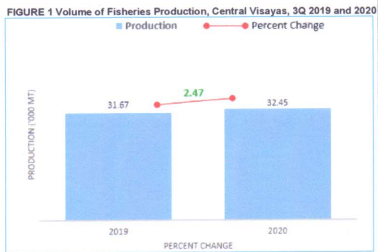
Among the fisheries subsectors, volume of production in Commercial and Municipal Fisheries exhibited increments while Aquaculture showed a decline in output (Table 1).
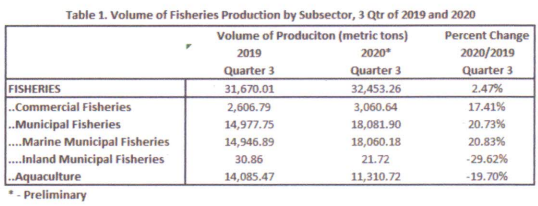
During the quarter, commercial fisheries volume of production was estimated at 3.06 thousand metric tons which was 17.41 percent higher than its level in the same quarter of the previous year of 2.61 thousand metric tons (Figure 2).
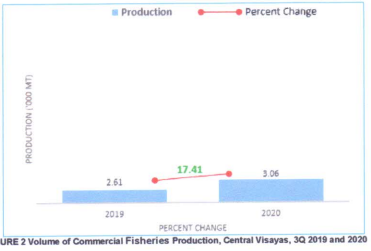
The subsector comprised 9.43 percent of the total fisheries production in Central Visayas for 3rd quarter of 2020 (Figure 5).
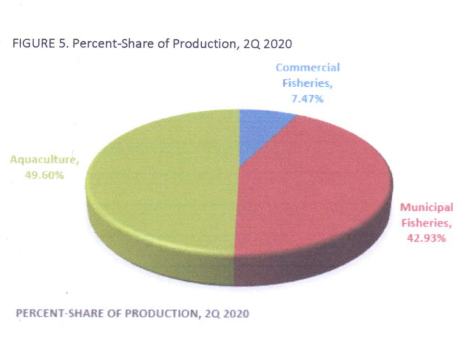
Municipal fisheries subsector reported an increase in output of 20.73 percent in the third quarter of 2020 compared to the same quarter of 2019 (Figure 3).
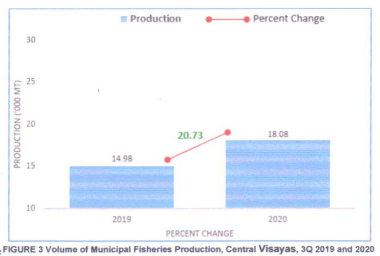
The volume of production during the quarter was registered at 18.08 thousand metric tons from the 14.98 thousand metric tons in the same period of 2019. Of the total volume of production for municipal fisheries, 99.88 percent came from unloadings from landing centers while the rest were caught from inland bodies of water in Central Visayas. The share of municipal fisheries to the total production in Central Visayas from July to September 2020 was 55.72 percent (Figure 5).
The total volume of harvests from aquaculture farms was estimated at 11.31 thousand metric tons during the period, lower by (19.70) percent compared with the previous year’s same quarter output of 14.09 thousand metric tons (Figure 4).
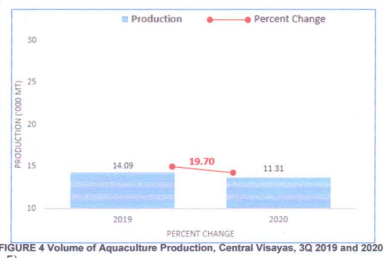
The share of aquaculture in Central Visayas to the total fisheries production was 34.85 percent (Figure 5).
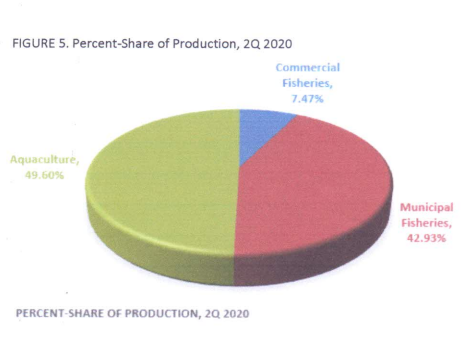
TECHNICAL NOTES
The Fisheries Survey is a nationwide quarterly survey conducted by the Philippine Statistics Authority (PSA) during the months of March, June, September and November. The following are the surveys that are being conducted by the PSA:
Quarterly Commercial Fisheries Survey (QCFS);
Quarterly Municipal Fisheries Survey (QMFS);
Quarterly Inland Fisheries Survey (QIFS);
Quarterly Aquaculture Survey (QAqS)
· The concepts and definitions applied in the fisheries survey can be found in the operational manuals. Some are given below:
a) Commercial fisheries – covers fishing operations in marine waters that make use of boats of more than three (3) gross tons.
b) Municipal fisheries – covers fishing operations in marine waters using fishing vessels of three (3) gross tons or less, or fishing not requiring the use of fishing vessels.
c) Inland fisheries – is the catching of fish, crustaceans, mollusks and other aquatic animals and plants in inland water like lakes, rivers, dams, marshes, etc. using fishing vessels of three (3) gross tons or less, or fishing not requiring the use of fishing vessels.
d) Fishing boat – is a type of watercraft, such as motorized/non-motorized banca, sailboat motorboat, etc., either licensed or not, used for fishing purposes.
e) Fishing ground – are areas in any body of water where fish and other aquatic resources congregate and become target of capture.
f) Landing center – is a place where the fish catch and other aquatic products are unloaded and traded.
g) Traditional landing center – is an area where fishermen could unload their catch and/or dock their fishing boats without any obligation or payment for the use of the place.
h) Nan-traditional landing center – is an area managed by PFDA, LGU & Private individuals, corporations, etc. and usually with structures and imposes fee for the maintenance of such.
i) Fishing gear – refers to any instrument or device and its accessories utilized in taking fish and other fishery species.
j) Active fishing gear – is a fishing device characterized by gear movements, and/or the pursuit of the target species by towing, lifting, and pushing the gears, surrounding, covering, dredging, pumping and scaring the target species to impoundments; such as, but not limited to trawl, purse seines, Danish seines, bag nets, “paaling”, drift gill net and tuna long line.
k) Passive fishing gear – is characterized by the absence of gear movements and/or the pursuit of the target species; such as, but not limited to hook and line, fishpots, traps and gill nets across the path of the fish. (RA 8550).
l) Inland fishing household – is a household with at least one member engaged in inland fishing.
m) Aquaculture – is a fishery operation involving all forms of raising and culturing of fish and other fishery species in fresh, brackish and marine water areas. (RA 8550)
n) Aquafarm – is a farming facility used in the culture or propagation of aquatic species including fish, mollusks, crustaceans and aquatic plants for purpose of rearing and culturing to enhance production.
o) Fishpond – refers to land-based type of aquafarm; a body of water (artificial or natural) where fish and other aquatic products are cultured, raised or cultivated under controlled conditions.
p) Fish pen – refers to an artificial enclosure constructed within a body of water for culturing fish, fishery/aquatic resources made up of bamboo poles closely arranged in an enclosure with wooden material, screen or nylon netting to prevent escape of fish.
q) Fish cage – refers to a stationary or floating fish enclosure made of synthetic net wire/bamboo screen or other materials set in the form of inverted mosquito net (“hapa” type) with or without cover with all sides either tied to poles staked to the water bottom or with anchored floats for aquaculture purposes.
r) Hatchery – is an aquafarm where brood stock eggs are hatched and reared into fry in body of water (artificial or natural) contained in tanks or ponds under controlled condition in saltwater and freshwater environment.
s) Rice fish – refers to an integrated farming system involving raising of fish in rice paddies.
t) Small Farm Reservoir – (small water body) includes reservoirs and lakes with an area of less than 10 m2, small ponds, canals. Irrigation canals, swamps and small, seasonal, inland floodpains. They may be permanent or temporary and can be separated into natural waters or constructed ones.
u) Oyster farm – is an aquafarm involved in the cultivation of oyster in shallow brackish or marine areas by any method for production purposes.
v) Mussel farm – is an aquafarm involved in the cultivation of mussel in shallow brackish or marine areas by any method for production purposes.
w) Seaweed farm – is an aquafarm involved in the cultivation of seaweed in suitable water areas by any method with appropriate intensive care for production in commercial quantities.
x) Brackishwater environment – refers to mixed seawater and freshwater and salinity varies with the tide (e.g. estuaries, mangroves, and mouth of rivers where seawater enters during high tide).
y) Freshwater environment – refers to water without salt or marine origin. It is pure fresh water. (e.g. Laguna de Bay, Taal Lake, Candaba Swamps, Liguasan Marsh and rivers, canals, dams and paddy fields and rice fields).
z) Marine water/Sea water environment – refers to inshore, open waters and inland seas in which the salinity generally exceeds 20%.
aa) Management system – is a system concerns on the decision on how the aquafarm operates consistent with the operator’s or family’s objectives and resources.
bb) Extensive – is a system where stocking rate ranges from 3,000 pcs to 5,000 pcs/ha for milkfish and 1 – 15 pcs/sq.m. for shrimps. The cultured species depend completely on natural food propagated in the pond with or without fertilization and depends solely on tidal water exchange.
cc) Semi-Intensive – refers to a system where stocking rate ranges from 16 – 25 pcs./sq.m. for shrimps and from 5,001 to 20,000 for bangus and 40,000 to 80,000/ha. for tilapia. This requires supplementary feeding of commercial pellets, trash fish, etc. aside from the natural food propagated in it. Water pumps are used aside from the tidal water and paddle wheels as aerators.
dd) Intensive – refers to a system where ponds are smaller about 1,000 to 5,000 sq.m; stocking rate ranges from 26 – 40 pcs. /sq.m. shrimps from 20,001 to 50,000/ha for bangus. The high-stocking could only be supported through major inputs such as formulated feeds mostly in pellet form. Water exchange is done through pumps and paddle wheels are also needed for aeration purposes.
ee) Culture system – refers to production practices applied.
ff) Monoculture – refers to the culture of single species in one compartment.
gg) Polyculture – refers to the culture of two or more species in one compartment.
hh) Others – refers to culture systems not elsewhere classified.
ii) Alternate culture system – refers to crop rotation of two species (e.g. interchanging bangus and prawn crops). For instance, bangus will be cultured from November to March followed by prawns from May to October.
jj) Bottom Monoline Method/Fixed Bottom Method – are constructed by the use of mangrove post or wooden stakes anchored/staked deep into the substrate at 10 meters apart and 32-cm. interval in rows. The seaweed planting materials (seed) or cuttings are tied to the nylon monolines at 20-25 cm intervals using soft plastic materials. The monolines are stretched and tied to the stakes at 0.3 – 0.5 meter away from the bottom during low tide. A culture method where bamboo poles either whole or halved are driven into the bottom where the water is not less than 1 meter deep during the lowest tide. These are aligned and spaced at 1 to 2 feet. The bamboo poles act as collectors.
kk) Floating Monoline – is a method where a raft or longlines can be constructed in any way feasible as long as it will buoy up the line with plants, which are at least 30-cm. submerged in water. The lines with plants are stretched with the raft/longlines. The raft/longlines should be anchored either at the bottom with a stone or tied to a bamboo pole. The lines used are the same as that used in fixed bottom monoline (for shellfish/seaweed).
ll) Triangular – is a method which uses polyethylene rope #12 as cultivation line fixed five meters from the bottom through a wooden stake embedded firmly to the seabed. A rope of smaller size (#7) is used to construct a triangle. A float using float ball or empty plastic container is provided at the triangle’s tips to add more buoyancy. The seedlings at the side of the triangles at 30 centimeters apart.
mm) Stake Method – “Tulus” is a culture method where bamboo poles either whole or halved are driven into the bottom where the water is not less than 1 meter deep during the lowest tide. These are aligned and spaced at 1 to 2 feet. The bamboo poles act as collectors.
nn) Hanging Method – “Bitin” is an off-bottom method of culture that is suitable in relatively deeper waters of at least 2.5 meters depth during the lowest tide. Empty oyster shells or coconut shells are used as collectors. The shells are hung to a meter of no. 10 galvanized iron wire having a space of about 4 inches by a loop on the wire.
oo) Spreading Broadcast Method – “Sabog” is a culture method which makes use of stones, gravels, empty oyster shells, and other media as collectors. These are positioned in hard bottom areas where natural populations of oyster/mussels are known to occur.
pp) Aquaculture production – refers to the volume harvested from the aquafarm. It includes those species harvested in marketable/matured size and in fresh form. The species harvested that are utilized as input to another operation like planting materials, are not included in the estimates of volume produced.
qq) Area – refers to the size of an aquafarm expressed in hectare. To compute the area: Area = Length x Width
rr) Operator – refers to a person, who takes technical and administrative responsibility of managing day-to-day aquafarm operation.
ss) Owner operator – refers to a person who owns and operates the farm, exercises technical initiatives and takes full economic risk and responsibility in the administration and operation of the farm.
tt) Caretaker – refers to any person in a farm who is in charge to watch over the farm, including feeding.
Approved by:
(SGD.) ARIEL E. FLORENDO
Regional Director

